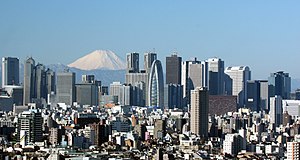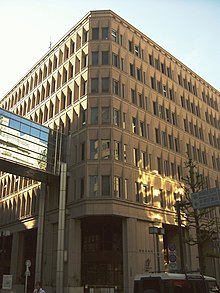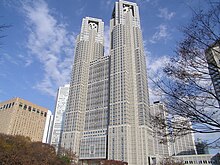Shinjuku
| Shinjuku-ku 新宿 区 |
||
|---|---|---|
| Geographical location in Japan | ||
|
|
||
| Region : | Kanto | |
| Prefecture : | Tokyo | |
| Coordinates : | 35 ° 42 ' N , 139 ° 43' E | |
| Basic data | ||
| Surface: | 18.23 km² | |
| Residents : | 349,511 (October 1, 2019) |
|
| Population density : | 19,172 inhabitants per km² | |
| Community key : | 13104-1 | |
| Symbols | ||
| Flag / coat of arms: | ||
| Tree : | Japanese zelkove | |
| Flower : | azalea | |
| town hall | ||
| Address : |
Shinjuku City Hall 1 - 4 - 1 , Kabuki-chō Shinjuku-ku Tōkyō 160-8484 |
|
| Website URL: | http://www.city.shinjuku.tokyo.jp/ | |
| Location of Shinjuku in Tokyo Prefecture | ||
Shinjuku ( Japanese 新宿 区 - ku , "district ~", English "~ City") is a ("special -") district and the administrative seat of the Japanese prefecture of Tokyo . It is located in western Tokyo .
history
During the 17th century
Shinjuku was named after a post office set up around 1698 on the main road Kōshū-kaidō , which led from Edo to Kai Province . Because of the residence of the Naitō clan from Shinano Province, the station was named "New Station Naitō" (Naitō-Shinjuku). It was along the road parallel to today's Shinjuku Gyoen (Naitōmachi) area.
1920 to 1945
In 1920 the city Naitō-Shinjuku (essentially the current districts of Shinjuku and Naitōmachi ) , which was established in 1889 as a municipality in the district of South Toshima (from 1896: Toyotama ), was incorporated into the then city of Tokyo . In 1932, with the incorporation of the previous district town of Yodobashi and other communities (in the area of today's Shinjuku district, the cities of Ōkubo , Totsuka and Ochiai ), areas west of today's Yamanote Line became part of the city of Tokyo.
Shinjuku was largely spared from the great Kantō earthquake in 1923 , as it is located in a seismically harmless area. The Nishi-Shinjuku district in particular is known today for its many skyscrapers that were built after the Yodobashi sewage treatment plant moved.
1945 to 2000
The 1945 air raids on Tokyo destroyed about 90% of the area around Shinjuku Station . After the war, the city was rebuilt according to an almost identical plan. Only in Kabukichō were there fundamental renewals.
The Shinjuku district was created in its current form in 1947 through the merger of the old districts of Yotsuya , Ushigome and Yodobashi .
In 1991, with the move of the prefectural government from Marunouchi , Chiyoda , the Shinjuku District became the administrative center of Tokyo Prefecture.
Origin of name
During the Edo period there were five major streets, all of which started from Nihombashi Bridge . Hotels were built along these streets, where post officials could rest their stagecoach horses. These were also built on Koshu Street, which was one of the five streets leading to Kofu , but there was a place where two hotels were at a greater distance from each other. Therefore, the Daimyo Naito gave the call to build another hotel, which was then named "Naito-Shinjuku" (Eng. New Naito Hotel) . When the area became a town in 1947, the name "Shinjuku" was adopted.
Attractions

Around the Shinjuku train station of the same name , which has one of the highest passenger volumes in the world, the following are concentrated in just two square kilometers:
- the most important commercial and administrative center of Japan with the second largest skyscraper district in the country after Minato in Nishi-Shinjuku . The neighborhood was built in the 1970s on the site of the city's former sewage treatment plant. In addition to the largest hotels in the city, there are the Mode Gakuen Cocoon Tower , the NTT Docomo Yoyogi Building and the Tokyo Metropolitan Government Building , in which the Tokyo Prefecture Administration (Tōkyō-to) is based. The Tokyo Prefecture represents the merger of the former Tokyo Prefecture (Tōkyō-fu) with the City of Tokyo (Tōkyō-shi), which was completed in 1943. The Tokyo prefecture administration thus fulfills the tasks of a prefecture administration and a town hall.
- the largest shopping district in Japan with almost a dozen huge department stores (including the 15-story Takashimaya department store "Takashimaya Times Square").
- the Imperial Shinjuku , one of the most famous parks in Japan, known for its cherry blossom is famous.
- Kabukichō , the largest (and one of the oldest) entertainment district in Japan with most of the city's cinemas, countless restaurants and pubs and, above all, a huge red light district as well as several dozen so-called love hotels and the Shinjuku City Hall.
- Shinjuku ni-chōme , Tokyo’s gay and lesbian entertainment district .
There are also several important universities in Shinjuku such as B. Waseda University . Not far from Shinjuku station is the Ōkubo district , which is the center of the Korean residents of Tokyo.
The well-known artist Yayoi Kusama opened her own Yayoi Kusama Museum here in September 2017 .
statistics
As of October 1, 2019, the district had a reported population of 349,511 and an area of 18.23 km² a population density of 19,172 people per km². However, because of the district's central role, it is estimated that the actual population is over a million at any time of the day or night. With almost 10%, Shinjuku has one of the highest proportions of foreigners of all Japanese communities.
City district (selection)
For a complete listing of all Shinjuku neighborhoods today, see the Shinjuku District District List of Tokyo .
- Shinjuku ( 新宿 )
- Ichigaya ( 市 ヶ 谷 )
- Kabukichō ( 歌舞 伎 町 )
- Nishi Shinjuku ( 西 新宿 )
- Ōkubo ( 大 久保 )
- Shinanomachi ( 信 濃 町 )
- Takadanobaba ( 高田 馬 場 )
- Yotsuya ( 四 谷 )
sons and daughters of the town
- Natsume Sōseki (1867-1916), writer
- Ōoka Shōhei (1909–1988), writer
- Tetsurō Tamba (1922-2006), actor
- Abe Shintarō (1924–1991), politician
- Mishima Yukio (1925-1970), writer
- Hidenao Nakagawa (* 1944), politician
- Shinzō Abe (* 1954), politician / 63. Prime Minister of Japan
- Takuma Satō (* 1977), Formula 1 racing driver
- Yōsuke Kamigata (* 1992), football player
- Colin Killoran (born 1992), soccer player
- Niall Killoran (* 1992), soccer player
- Tabinas Jefferson (* 1998), Filipino soccer player
politics
Shinjuku-ku's mayor has been Ken'ichi Yoshizumi, a former LDP prefectural member of parliament since 2014 . In 2018 he was re-elected for a second term by a clear majority with the support of the LDP and Kōmeitō against the LP politician Tetsuo Nozawa ( KDP , KPJ , LP, SDP ). The turnout increased slightly to 28.2%. The 38-member Shinjuku District Parliament was re-elected in the 2019 unified regional elections.
The district forms a four-mandate constituency for the prefecture parliament . In the last election in 2017 , Shinjuku elected one MP each from Tomin First no Kai , KPJ, Kōmeitō and LDP.
For the national House of Representatives, most of the Shinjuku district, together with Chiyoda and Minato, make up the constituency of Tokyo 1 , which the constitutional democrat Banri Kaieda narrowly won against the liberal democrat Miki Yamada in the 2017 House of Representatives election . A small part of the district in the northwest (parts of the former city of Ochiai ) has belonged to constituency 10 since 2017, which elected Liberal Democrat Hayato Suzuki in 2017.
Partnerships

Shinjuku has partnerships with the following administrative units:
- Mitte district of Berlin, Germany
- District Dongcheng , Beijing , People's Republic of China
- Lefkada Prefecture , Greece
Neighboring cities and communities
Web links
- Official website - Japanese, English, Chinese and Korean
Individual evidence
- ^ Shinjuku City , Pages for English Speaking Foreigners
- ↑ History of the Shinjuku District ( Memento of the original from October 26, 2016 in the Internet Archive ) Info: The archive link was automatically inserted and has not yet been checked. Please check the original and archive link according to the instructions and then remove this notice.
- ↑ Ichikawa, 2003
- ↑ a b History of the origin of the name on the Shinjuku website. In: Shinjuku Official Website. Retrieved July 24, 2016 (Japanese).
- ^ History of the origin of the name of Shinjuku . May 4, 2009. Retrieved July 27, 2012.
- ↑ Shinjuku District Parliament : Factions , accessed June 8, 2019.
- ↑ 「新宿 を よ り 発 展 さ せ る」 区長 に 吉 住 さ ん 再 選 . In: Tōkyō Shimbun . November 13, 2018. Retrieved June 8, 2019 (Japanese).
- ↑ 東京 ・ 新宿 区長 選 は 自 民 、 公 明 推薦 の 吉 住 氏 が 再 選 . In: Sankei Shimbun . November 11, 2018. Retrieved June 8, 2019 (Japanese).
- ↑ 統一 地方 選 2019> 東京> 新宿 区 議 選 . In: Tōkyō Shimbun . April 2019, accessed on June 7, 2019 (Japanese).
- ↑ Tōkyō Shimbun : Prefectural parliamentary election in Tokyo 2017 , result Shinjuku-ku






